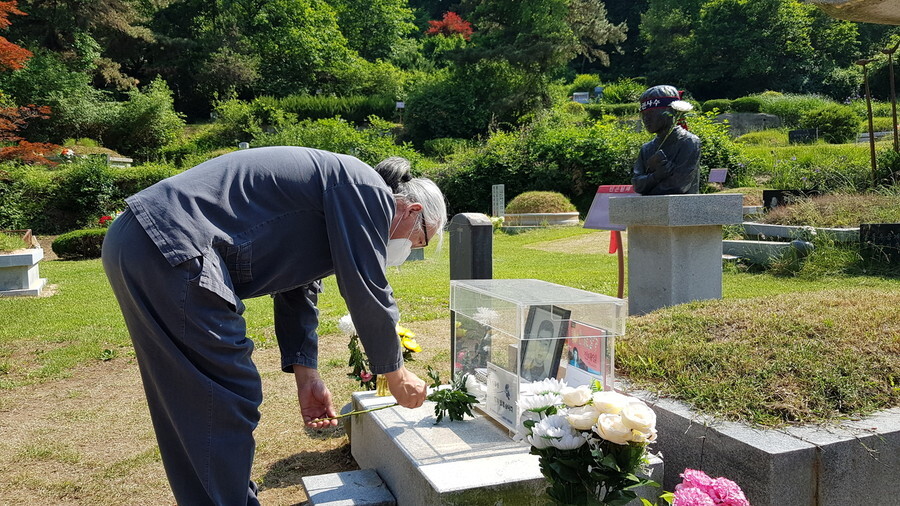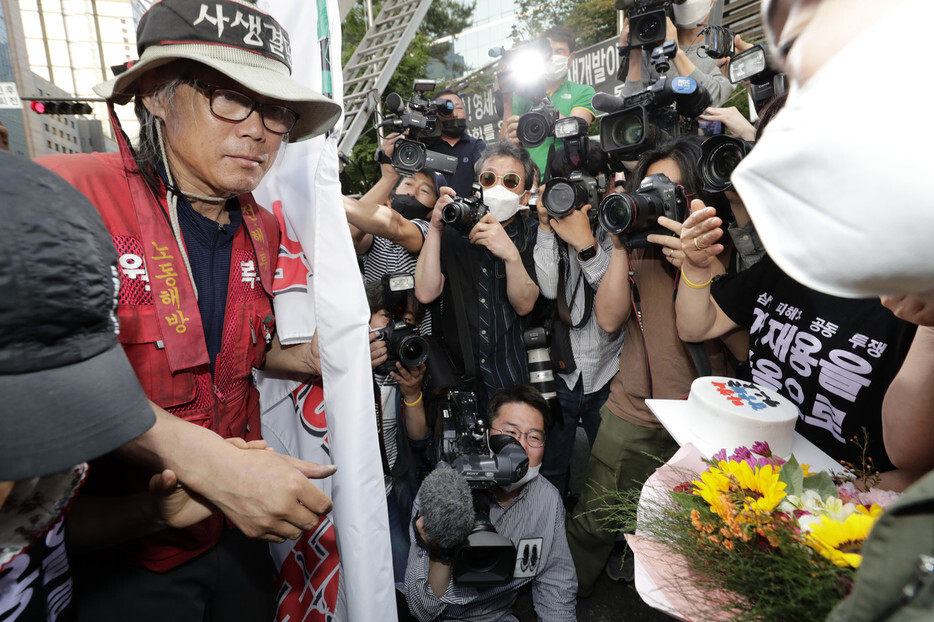hankyoreh
Links to other country sites 다른 나라 사이트 링크
Dismissed Samsung worker ends 355-day protest on top of CCTV tower

No longer was he wearing the band on his forehead that read “Do or die.” Instead, he was gently placing a bouquet of chrysanthemums in front of a gravestone.
On May 30, Kim Yong-hee visited the grave of Jeon Tae-il at Moran Cemetery in Namyangju, Gyeonggi Province. It was the day after the 62-year-old Kim first set foot on the ground after a 355-day aerial protest, having ascended a tower in front of Samsung’s Seoul headquarters near Gangnam Station to protest his unjust dismissal from the company. His reasons for making Jeon’s grave his first stop after coming down from his protest were simple.
Jeon Tae-il was a factory worker who burned himself to death in 1970 in protest of poor working conditions in South Korea’s industrial facilities.
Kim described his aerial protest as “a fight with myself against death,” suggesting how challenging and lonely that fight was. “Feelings of panic were especially hard to endure. I found myself thinking that, if I jumped down, the pain might go away,” he said.
But whenever Kim found himself pondering that extreme option, there was something that held him back — the biography of Jeon Tae-il. “At my lowest moments, I read the book about Jeon and found myself in its pages. I found great strength in the scenes of Jeon suffering from workplace abuse. That’s why I thought this should be the first place I visit once I came down from the tower.”

There were plenty of people who gave Kim their solidarity and support. “The biggest help I had in reaching a solution was my colleagues. It’s hard to express how grateful I feel to them,” he said.
“If I’d jumped down because of my own inner conflict, it would have shown labor being defeated, and I didn’t want to do that,” Kim said, explaining how he resisted that urge.
Kim was fired from Samsung Aerospace in 1995 while trying to set up a labor union there. He spent the next 25 years fighting to be reinstated to his position. “Throughout those 25 years, I never forgot about my father. I felt very guilty about him, and I felt sorry for not having done my duties as a husband and a father,” he said. In 1991, Kim’s father vanished, leaving a letter behind in which he asked Kim to give up his labor union activities.
Moving forward, Kim is thinking about lending a hand of solidarity to workers struggling in a challenging labor environment. “When I came back down to earth, what made me really excited was being reunited with the colleagues [who supported me], holding their hands, and crying together. I want to go around to protests around the country and help them out by joining their struggle, one protest at a time,” he said.
By Kang Jae-gu, staff reporter
Please direct comments or questions to [english@hani.co.kr]

Editorial・opinion
![[Column] Season 2 of special prosecutor probe may be coming to Korea soon [Column] Season 2 of special prosecutor probe may be coming to Korea soon](https://flexible.img.hani.co.kr/flexible/normal/500/300/imgdb/original/2024/0426/3317141030699447.jpg) [Column] Season 2 of special prosecutor probe may be coming to Korea soon
[Column] Season 2 of special prosecutor probe may be coming to Korea soon![[Column] Park Geun-hye déjà vu in Yoon Suk-yeol [Column] Park Geun-hye déjà vu in Yoon Suk-yeol](https://flexible.img.hani.co.kr/flexible/normal/500/300/imgdb/original/2024/0424/651713945113788.jpg) [Column] Park Geun-hye déjà vu in Yoon Suk-yeol
[Column] Park Geun-hye déjà vu in Yoon Suk-yeol- [Editorial] New weight of N. Korea’s nuclear threats makes dialogue all the more urgent
- [Guest essay] The real reason Korea’s new right wants to dub Rhee a founding father
- [Column] ‘Choson’: Is it time we start referring to N. Korea in its own terms?
- [Editorial] Japan’s rewriting of history with Korea has gone too far
- [Column] The president’s questionable capacity for dialogue
- [Column] Are chaebol firms just pizza pies for families to divvy up as they please?
- [Column] Has Korea, too, crossed the Rubicon on China?
- [Correspondent’s column] In Japan’s alliance with US, echoes of its past alliances with UK
Most viewed articles
- 1‘We must say no’: Seoul defense chief on Korean, USFK involvement in hypothetical Taiwan crisis
- 2[Column] Season 2 of special prosecutor probe may be coming to Korea soon
- 3N. Korean delegation’s trip to Iran shows how Pyongyang is leveraging ties with Moscow
- 4Amnesty notes ‘erosion’ of freedom of expression in Korea in annual human rights report
- 5[Reportage] On US campuses, student risk arrest as they call for divestment from Israel
- 6Korea sees more deaths than births for 52nd consecutive month in February
- 7[Editorial] New weight of N. Korea’s nuclear threats makes dialogue all the more urgent
- 8‘Weddingflation’ breaks the bank for Korean couples-to-be
- 9[Column] Has Korea, too, crossed the Rubicon on China?
- 10[Column] Park Geun-hye déjà vu in Yoon Suk-yeol